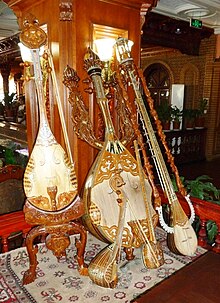
A lute is any plucked string instrument with a neck and a deep round back enclosing a hollow cavity, usually with a sound hole or opening in the body. It may be either fretted or unfretted.
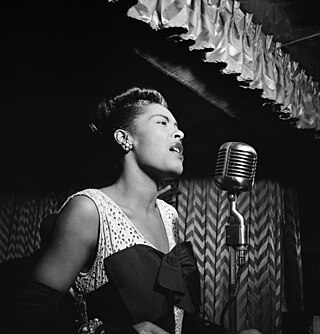
A song is a musical composition performed by the human voice. The voice often carries the melody using patterns of sound and silence. Songs have a structure to them, such as the common ABA form, and are usually made of sections that are repeated or performed with variation later. A song without instruments is said to be a cappella.

The sitar is a plucked stringed instrument, originating from the Indian subcontinent, used in Hindustani classical music. The instrument was invented in medieval India, flourished in the 18th century, and arrived at its present form in 19th-century India. Khusrau Khan, an 18th-century figure of the Mughal Empire has been identified by modern scholarship as the inventor of the sitar. According to most historians, he developed the sitar from the setar, an Iranian instrument of Abbasid or Safavid origin. Another view supported by a minority of scholars is that Khusrau Khan developed it from Veena.
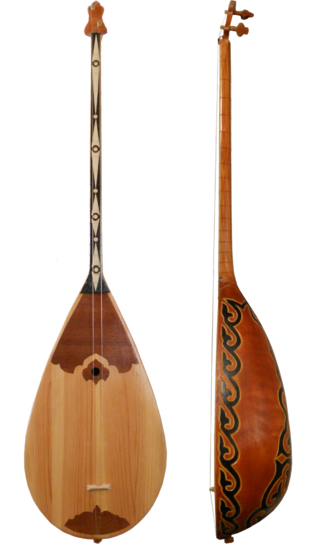
The Dombra, also known as Dombyra, is a long-necked musical string instrument used by the Kazakhs, Hazaras, Uzbeks, Tajiks, Nogais, Bashkirs, and Tatars in their traditional folk music. The Dombura shares certain characteristics with the komuz and dutar instruments, such as its long, thin neck and oblong body shape. It is a popular instrument mostly among Turkic communities in Central Asian countries.

The music of China consists of many distinct traditions, often specifically originating with one of the country's various ethnic groups. It is produced within and without the country, involving either people of Chinese origin, the use of traditional Chinese instruments, Chinese music theory, or the languages of China. It includes traditional classical forms and indigenous folk music, as well as recorded popular music and forms inspired by Western culture.

The cittern or cithren is a stringed instrument dating from the Renaissance. Modern scholars debate its exact history, but it is generally accepted that it is descended from the Medieval citole. Its flat-back design was simpler and cheaper to construct than the lute. It was also easier to play, smaller, less delicate and more portable. Played by people of all social classes, the cittern was a popular instrument of casual music-making much like the guitar is today.
Music of Serbia represents the musical heritage of Serbia, both historical and modern. It has a variety of traditional music styles, which are part of the wider Balkan musical tradition, with its own distinctive sound and characteristics.

The komuz or qomuz is an ancient fretless string instrument used in Central Asian music, related to certain other Turkic string instruments, the Mongolian tovshuur, and the lute. The instrument can be found in Turkic ethnic groups, from China to Turkey. Forms of this instrument are used in China by the Naxi people and are called Huobusi, Hebisi , and Hunbusi.
A Muqam is the melody type used in the music of the Uyghurs, that is, a musical mode and set of melodic formulas used to guide improvisation and composition.
The music of Crete, also called kritika, refers to traditional forms of Greek folk music prevalent on the island of Crete in Greece. Cretan traditional music includes instrumental music, a capella songs known as the rizitika, "Erotokritos," Cretan urban songs (tabachaniotika), as well as other miscellaneous songs and folk genres.
The musical traditions of Central Asia mirror the immense diversity found in the cultures and populations residing in the region. Principal instrument types are two- or three-stringed lutes, the necks either fretted or fretless; fiddles made of horsehair; flutes, mostly sige at both ends and either end-blown or side-blown; and jew harps, mostly metal. Percussion instruments include frame drums, [[Tam origin of the bowed string== Use of the bowed string is thought to originate with nomads who mainly used the snake-skin, covered horsetail-bowed lute. In Mongolia instruments like the morin khuur or horse-head fiddle survive today.

A setar is a stringed instrument, a type of lute used in Persian traditional music, played solo or accompanying voice. It is a member of the tanbur family of long-necked lutes with a range of more than two and a half octaves. Originally a three stringed instrument, a fourth string was added by Mushtaq Ali Shah by the mid 19th century. It is played with the index finger of the right hand.
Erkin Abdulla is a Uyghur musician. His musical style bridges contemporary folk, Uyghur pop and flamenco.
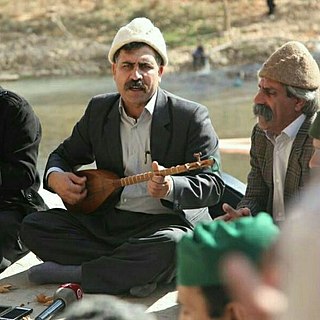
The term Tanbur can refer to various long-necked string instruments originating in Mesopotamia, Southern or Central Asia. According to the New Grove Dictionary of Music and Musicians, "terminology presents a complicated situation. Nowadays the term tanbur is applied to a variety of distinct and related long-necked lutes used in art and folk traditions. Similar or identical instruments are also known by other terms." These instruments are used in the traditional music of Iran, India, Kurdistan, Armenia, Afghanistan, Azerbaijan, Pakistan, Turkey, Tajikistan, Kazakhstan, and Uzbekistan.
Dolan refers to a people or region of what is now Xinjiang Province, China. People who call themselves Dolan can be found in Awat County, the Yarkand River valley, the Tarim River valley and the Lop Nur region of present-day Xinjiang. Though modern Dolan people now speak the vernacular dialect, the term refers to an earlier culture and civilization in the region. The history of this people is little known. Some scholars and travelers believed the Dolan of the Yarkand River valley to be a Kazakh or Kyrgyz group that settled in the area during the Qing dynasty. This belief was based on their noticeably different physiognomy and language and their semi-nomadic lifestyles.
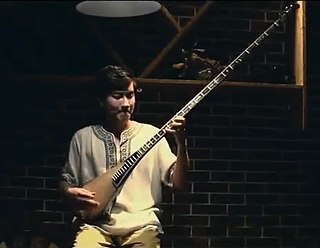
The tembor is a long-necked lute used in the music of Xinjiang, a diverse region of western China. Specifically, it is used by the Uyghur ethnic group.
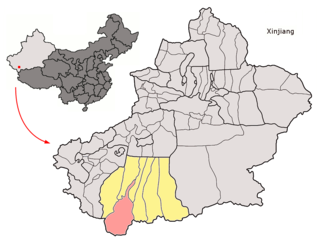
The 2011 Hotan attack was a bomb-and-knife attack that occurred in Hotan, Xinjiang, China on 18 July 2011. According to witnesses, the assailants were a group of 18 young Uyghur men who opposed the local government's campaign against the burqa, which had grown popular among older Hotan women in 2009 but were also used in a series of violent crimes. The men occupied a police station on Nuerbage Street at noon, killing two security guards with knives and bombs and taking eight hostages. The attackers then yelled religious slogans, including ones associated with Jihadism, as they replaced the Chinese flag on top of a police station with another flag, the identity of which is disputed.
The rawap or rubab is an Eastern Iranian fretted plucked long-necked stringed instrument also used in folk music by residents of the Uyghur autonomous region of Xinjiang, Western China. The history of the instrument dates back to the Ancient Iran including modern Tajikistan and spreading in the 14th century to Turkic cultures including southern Xinjiang. It is an instrument of the Tajiks also used in Uzbekistan. It's particularly associated with Tajik music and culture including Tajiks of Bukhara and Samarkand.

The satar is a traditional Uyghur long-necked bowed lute. It is used by Uyghur people in Xinjiang, western China, and is an important instrument to play maqams.

